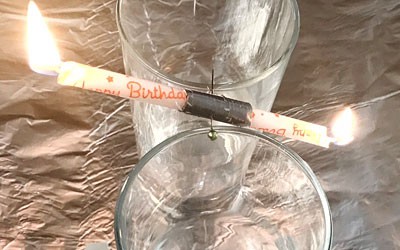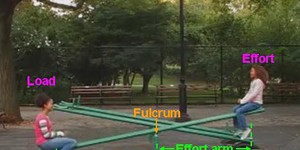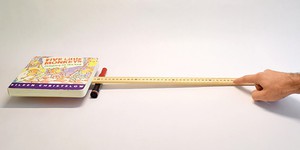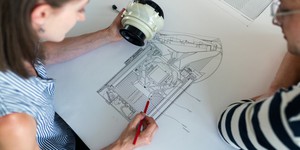Summary
Introduction
Do you love playing on a seesaw? Why is it that depending on where you sit on the beam, and the weight of the person on the other side, you either fly up into the air or fall down to the ground? And why is it so difficult to perfectly balance the seesaw? It can all be explained with physics! In this activity, you will investigate the balancing forces of a seesaw—with a seesaw made of candles!
Materials
- Two identical birthday candles
- Strong tape
- Needle that is longer than the candle's diameter
- Aluminum foil
- Knife
- Two glasses the same height
- Lighter or matches
- Adult helper
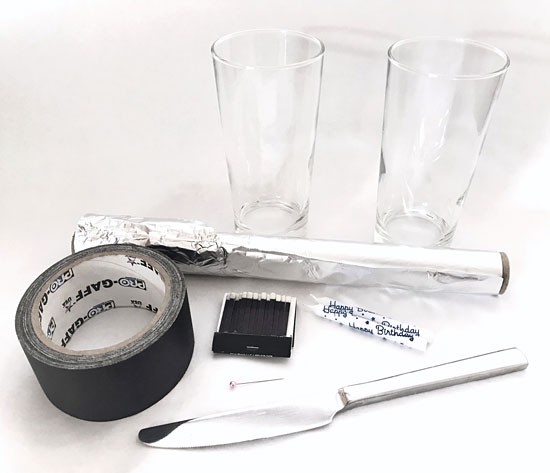 Image Credit: Svenja Lohner, Science Buddies / Science Buddies
Image Credit: Svenja Lohner, Science Buddies / Science Buddies
Prep Work
- Tape the birthday candles together at their ends, so that both wicks are facing opposite directions.
 Image Credit: Svenja Lohner, Science Buddies / Science Buddies
Image Credit: Svenja Lohner, Science Buddies / Science Buddies
- Put a large piece of aluminum foil on your work area to protect it from any wax spills.
- Set the two glasses next to each other in the middle of the aluminum foil. The gap between the glasses should be small enough to place the needle across it.
- Take the needle and push it all the way through the side of the candle exactly where the ends of both candles meet. This should be exactly in the middle between both wicks. If it is too difficult to push the needle through the candle, try to heat the needle in a flame before you push it through the wax.
 Image Credit: Svenja Lohner, Science Buddies / Science Buddies
Image Credit: Svenja Lohner, Science Buddies / Science Buddies
Instructions
- Place the candle in the gap between the glasses so that the parts of the needle that are sticking out on each side of the candle rest on the rim of each glass.Can you see the similarities between your experimental setup and a seesaw?
- If your candle seesaw is unbalanced, change the location of the needle in the candle. Once the needle is placed exactly in the middle of the two candles, the seesaw should be balanced.Why does the needle have to be exactly in the middle of the candle to balance the seesaw?
 Image Credit: Svenja Lohner, Science Buddies / Science Buddies
Image Credit: Svenja Lohner, Science Buddies / Science Buddies
- Make sure that your surface is covered with aluminum foil along the entire length of the candle.
- Once the candle is balanced and doesn't drop down on either side, ask your adult helper to carefully light up both candles. Don't light both candles at the same time—wait for a couple of seconds before you light the second one.
- Watch how both candles burn and observe the movement of your candle seesaw.What happens? If you see movement, can you explain why the candle seesaw is moving?
- Once the candles burn down by about one fourth, blow out both candles and cut the top (approximately 1 cm or about ½ inch) of one of the candles.
- Place the candle between the glasses again, so that the parts of the needle that are sticking out on each side of the candle rest on the rim of each glass.Is the seesaw still balanced as before? Why or why not?
- Again, ask your adult helper to light both candles the same way as before.
- Watch the candles burn and observe what happens.How are your observations different this time?
- Make sure to blow out both candles before they burn completely.
What Happened?
Did you notice that what you were building resembled a seesaw? Both candles taped together formed a long beam that was attached to the needle, which acted as the pivot (or fulcrum). The candle beam was able to rotate freely from one side to the other just like a real seesaw. As you don't put any extra weight on the candle beam as you would on a playground seesaw, the only force pulling down on the beam is the weight of the candle itself. To balance the seesaw, it is important that both forces pulling down on each side of the beam are exactly the same. This is only true if the needle is placed exactly in the middle of the candle beam. If one side is slightly longer, this would also make it heavier and it would drop down as you might have observed. However, if the needle is placed in the middle, the gravitational forces pulling down on each side should cancel each other out and it should stay balanced.
This changes once you light the candles. When the candle is burning, a chemical reaction occurs that converts the candle wax to a gas. You probably also noticed that the solid wax turned into a liquid and dripped onto the aluminum foil. The wax lost through burning and dripping makes the candle shorter, and therefore, lighter. As this side of the candle beam becomes lighter, it moves upwards, while the other, heavier side drops down. The rotation is reversed once the other candle loses wax and becomes lighter again. The key to this seesaw movement is that both candles are not losing the same amount of wax at the same time. This is the reason why you have to light them one after the other. If both candles start burning at exactly the same time and lose the same amount of wax at the same time, the candle seesaw would stay balanced.
If you cut part of the candle on one side, the longer, now heavier side of the beam would drop down. When you lit the candles, you probably noticed that the candle seesaw didn't move at all, as the longer side will always be heavier while both candles are burning. However, if you would have only lit up the candle on the heavier side, you would have noticed that as soon as the candle burnt down enough to make it shorter and lighter, the seesaw dropped down on the other side.
Digging Deeper
Seesaws are great playground equipment for children. They are not only fun to play with, but also provide an excellent opportunity to explore a type of simple machine designed to lift objects much heavier than you would be able to lift by yourself. A seesaw is a specific type of lever and consists of a long beam that is attached to a pivot called the fulcrum. As soon as you put weight on one end by sitting on one side of the beam, it drops to the ground. This is because the force of gravity is acting on the mass of your body, pulling the beam down. How much weight is pulling down on the beam depends on your body mass. The heavier you are, the larger the gravitational force. To balance the beam again, you need a counteracting force on the other side. One possibility is to place a second person with the same weight on the other side of the beam. Once the same force is pulling down on each side of the beam, the seesaw is balanced.
However, you might know from experience that it is not only weight that matters, but where people are seated on the beam as well. Two people with the same body mass sitting on either side of the beam can still change the balance and make the seesaw rotate by moving farther from or closer to the center of the beam. The rotation of the beam is caused by the turning force, also called torque, which takes into account the force pulling down on the beam and the location of the applied force.
The seesaw will stop rotating once the turning forces are equal on both sides and cancel each other out, which is stated by the law of the lever. This law also explains why you are able to lift very heavy objects with a lever. When the object on one side is too heavy for you to lift, you just have to move farther away from the center of the beam until your turning force is greater than the one on the other side.
Ask an Expert
For Further Exploration
- Repeat the experiment, and this time, don't place the needle in the middle of the candle beam. One side should be heavier, similar to when you cut the top of one candle in the second part of the experiment. Then only light the candle on the longer side and watch the candle burn.
Related Resources
Project Ideas
Lesson Plans
- 3-5-ETS1-3. Plan and carry out fair tests in which variables are controlled and failure points are considered to identify aspects of a model or prototype that can be improved.


